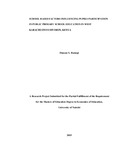| dc.description.abstract | This research study aimed at investigating the school based factors influencing
pupils’ participation in public primary schools education in West Karachuonyo
Division Rachuonyo North District, Kenya. Specifically, the study sought to
determine the influence of instructional materials on pupils participation in public
primary schools, determine the effects of teacher qualifications on pupils
participation in public primary school, determine how school curriculum effects
pupils participation in public primary school education, assess the influence of
guidance and counseling on pupils participation in public primary school
education and establish the influence of physical facilities on pupils participation
in primary schools in West Karachuonyo Division. This study was guided by
Education Production Function theory as advocated by Coleman 1960 in
Psacharopoulos and Woodhall (1985). The study was conducted using the
descriptive survey design. The target population consisted of the 72 primary
schools, 72 head teachers, 432 teachers and 16500 pupils, that is from class 4 to 8
(AEOs office, 2012) who had information on school based factors influencing
pupils’ participation in primary school education. Head teachers (36), teachers
(196) and pupils (370) were the sample size of the target respondents for this
study. Research instruments used to collect data were questionnaires for teachers
and pupils and an interview schedule for head teachers. The researcher used the
test retest method to enhance instrument reliability. The study yielded data that
required both qualitative and quantitative analysis. Quantitative data was analysed
using SPSS computer programme version 17.0 and qualitative data manually.
Presentation was done using frequency distribution tables with values and
percentages. From the findings of the study, it was established that head teachers
(44.4%) and teachers (40.0%) had taught for 16 and above years since they left
college. Besides, availability of qualified teachers, through in-service courses,
seminars or workshops, determines the participation of pupils in schools. The
results also indicate that 71.0% of pupils reported that they had repeated classes.
However, it is not only poor performance leading to repetition but also lack of
fees and indiscipline among some pupils. There were some factors as a result of
peer pressure contributing to pupils’ dropout. Majorly cited factors were
indiscipline cases (31.8%) and pupils’ negative attitude towards class work
(28.2%). The study concludes that head teachers’ and teachers’ provision of
guidance and counseling to pupils would enable them complete the eight years in
primary school. Through guiding and counseling also most girls would achieve
their dreams in life by avoiding early pregnancy. The researcher recommends
parents to offer full support to their children and also to work hand in hand with
teachers to curb issues of absenteeism and enable pupils complete school. Also,
public primary schools to be equipped with adequate teaching and learning
resources to enable pupils complete school. Basing on areas for further research,
the study recommends researches on the role Ministry of Education and other
collaborating partners to curb dropout in public primary schools in Kenya, and
relationship between educational level of the parents and the level of educational
attainment of the children. | en_US |

